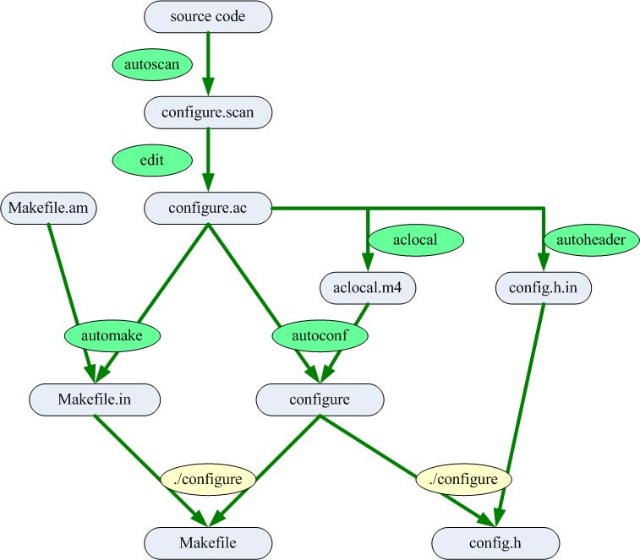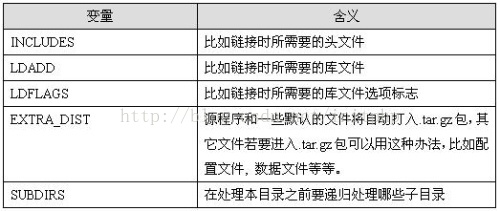参考代码
一、Autotools 脚本工具 autogen.sh:[参考文章]
#!/bin/sh echo "Running aclocal..." ; aclocal $ACLOCAL_FLAGS || exit 1 echo "Running autoconf..." ; autoconf || exit 1 echo "Running autoheader..." ; autoheader || exit 1 echo "Running automake..." ; automake --add-missing --copy --gnu || exit 1 ./configure "$@"
二、确保有配置文件:configure.ac (根目录下1个) 、Makefile.am (每个目录下各1个)
/configure.ac 文件内容:
# -*- Autoconf -*-
# Process this file with autoconf to produce a configure script.
AC_PREREQ([2.69])
AC_INIT(study_cc, 1.0, phpgo8642@163.com)
AC_CONFIG_SRCDIR([main.c])
AC_CONFIG_HEADERS([config.h])
AM_INIT_AUTOMAKE() #【新增加】
# Checks for programs.
AC_PROG_CC
# Checks for libraries.
# Checks for header files.
AC_CHECK_HEADERS([stdlib.h])
# Checks for typedefs, structures, and compiler characteristics.
# Checks for library functions.
AC_CONFIG_FILES( #【新增加】
Makefile
src/Makefile
)
AC_OUTPUT
/Makefile.am 文件内容:
SUBDIRS=src
/src/Makefile.am 文件内容:
bin_PROGRAMS=main main_SOURCES=main.c common.h common.c
关于Autotools
我们前面的章节中已经讲到了Makefile的使用(点击进入查看文章)。我们知道在Linux下面如果编译一个比较大型的项目,我们可以通过Makefile的方式来完成。
但是,我们又蛋疼了,Makefile拥有复杂的语法结构,甚至让人难以领会,当我们项目非常大的时候,维护Makefile会成为一件非常头疼的事情。于是我们就有了Autotools工具,专门用来生成Makefile,这个工具让我们很大程度的降低了开发的难度。
Autotools并不是一个工具,而是一系列工具:
- autoscan
- aclocal
- autoconf
- autoheader
- automake
记住,这一系列工具看着复杂,最终的目标还是生成Makefile
一般情况下系统中都会默认安装这一系列工具,如果未安装,则在CenterOS中可以通过下面命令安装:
sudo yum install automake
C源文件同一目录下Autotools的使用
如果你的源文件都放在同一个目录下面,那么使用Autotools的时候会相对简单很多。比较著名的开源软件Memcache也是放在同一目录下的,你可以去看下它的源码包。
下面会按照步骤来实现同一目录下的Autotools工具的使用。
1. 源代码例子
入口文件main.c
#include <stdio.h>
#include <stdlib.h>
#include <unistd.h>
#include "sum.h"
#include "get.h"
//入口主函数
int main() {
int x = 10;
int y = 20;
int z = sum(&x, &y);
puts("This is Main");
printf("Z:%d\n", z);
x = 20;
z = get(&x, &y);
printf("Z:%d\n", z);
return 1;
}
sum.h 和 sum.c
#include <stdio.h> #include <stdlib.h> #include <unistd.h> int sum(int *x, int *y);
#include "sum.h"
#include "val.h"
int sum(int *x, int *y) {
val(x);
puts("This is SUM Method!=========HDH");
return *x + *y;
}
val.h 和 val.c
#include <stdio.h> #include <stdlib.h> #include <unistd.h> int val(int *x);
#include "val.h"
int val(int *x) {
puts("This is Value==");
printf("X:%d \n", *x);
return 0;
}
get.h 和 get.c
#include <stdio.h> #include <stdlib.h> #include <unistd.h> int get(int *x, int *y);
#include "get.h"
int get(int *x, int *y) {
puts("This is get");
return (*x) * (*y);
}
上面这个例子,我们在Makefile这篇文章中已经讲解过如何来手工编写Makefile编译。这边的话我们继续使用这个例子,实现Autotools的工具编译。
[admin@localhost test_c2]$ ls get.c get.h main.c sum.c sum.h val.c val.h
2. Autoscan命令
第一步,我们需要在我们的项目目录下执行autoscan命令。这个命令主要用于扫描工作目录,并且生成configure.scan文件。并且configure.scan需要重命令成configure.ac,然后编辑这个配置,我们才能继续执行后面的命令。
[admin@localhost test_c2]$ autoscan [admin@localhost test_c2]$ ls autoscan.log configure.scan get.c get.h main.c sum.c sum.h val.c val.h [admin@localhost test_c2]$ mv configure.scan configure.ac [admin@localhost test_c2]$ ls autoscan.log configure.ac get.c get.h main.c sum.c sum.h val.c val.h
我们需要编辑configure.ac文件,首先我们打开configure.ac文件:
# -*- Autoconf -*- # Process this file with autoconf to produce a configure script. AC_PREREQ([2.69]) AC_INIT([FULL-PACKAGE-NAME], [VERSION], [BUG-REPORT-ADDRESS]) AC_CONFIG_SRCDIR([main.c]) AC_CONFIG_HEADERS([config.h]) # Checks for programs. AC_PROG_CC # Checks for libraries. # Checks for header files. AC_CHECK_HEADERS([stdlib.h unistd.h]) # Checks for typedefs, structures, and compiler characteristics. # Checks for library functions. AC_OUTPUT
我们修改成:
# -*- Autoconf -*- # Process this file with autoconf to produce a configure script. AC_PREREQ([2.69]) AC_INIT(hello,1.0,test@qq.com) AM_INIT_AUTOMAKE(hello,1.0) AC_CONFIG_SRCDIR([main.c]) AC_CONFIG_HEADERS([config.h]) AM_INIT_AUTOMAKE() #【新增加】 # Checks for programs. AC_PROG_CC # Checks for libraries. # Checks for header files. AC_CHECK_HEADERS([stdlib.h unistd.h]) # Checks for typedefs, structures, and compiler characteristics. # Checks for library functions. AC_CONFIG_FILES(Makefile) #【新增加】 AC_OUTPUT
configure.ac标签说明:
|
标签 |
说明 |
|
AC_PREREQ |
声明autoconf要求的版本号 |
|
AC_INIT |
定义软件名称、版本号、联系方式 |
|
AM_INIT_AUTOMAKE |
必须要的,参数为软件名称和版本号 |
|
AC_CONFIG_SCRDIR |
宏用来侦测所指定的源码文件是否存在, 来确定源码目录的有效性.。此处为当前目录下main.c。 |
|
AC_CONFIG_HEADER |
宏用于生成config.h文件,以便 autoheader 命令使用。 |
|
AC_PROG_CC |
指定编译器,默认GCC |
|
AC_CONFIG_FILES |
生成相应的Makefile文件,不同文件夹下的Makefile通过空格分隔。例如:AC_CONFIG_FILES([Makefile src/Makefile]) |
|
AC_OUTPUT |
用来设定 configure 所要产生的文件,如果是makefile,configure 会把它检查出来的结果带入makefile.in文件产生合适的makefile。 |
3. Aclocal命令
第二步,执行aclocal命令。扫描 configure.ac 文件生成 aclocal.m4文件,该文件主要处理本地的宏定义,它根据已经安装的宏、用户定义宏和 acinclude.m4 文件中的宏将 configure.ac 文件需要的宏集中定义到文件 aclocal.m4 中。
[admin@localhost test_c2]$ aclocal [admin@localhost test_c2]$ ls aclocal.m4 autom4te.cache autoscan.log configure.ac get.c get.h main.c sum.c sum.h val.c val.h
4. Autoconf命令
第三步,执行autoconf命令。这个命令将 configure.ac 文件中的宏展开,生成 configure 脚本。这个过程可能要用到aclocal.m4中定义的宏。
[admin@localhost test_c2]$ autoconf [admin@localhost test_c2]$ ls aclocal.m4 autom4te.cache autoscan.log configure configure.ac get.c get.h main.c sum.c sum.h val.c val.h [admin@localhost test_c2]$
5. Autoheader命令
第四步,执行autoheader命令。该命令生成 config.h.in 文件。该命令通常会从 "acconfig.h” 文件中复制用户附加的符号定义。该例子中没有附加的符号定义, 所以不需要创建 "acconfig.h” 文件。
6. 创建Makefile.am文件
第五步,创建Makefile.am文件。Automake工具会根据 configure.ac 中的参量把 Makefile.am 转换成 Makefile.in 文件。最终通过Makefile.in生成Makefile文件,所以Makefile.am这个文件非常重要,定义了一些生成Makefile的规则
Makefile.am:
AUTOMARK_OPTIONS = foreign bin_PROGRAMS = hello hello_SOURCES = main.c val.h val.c get.h get.c sum.h sum.c
1. AUTOMAKE_OPTIONS:由于GNU对自己发布的软件有严格的规范, 比如必须附带许可证声明文件COPYING等,否则automake执行时会报错. automake提供了3种软件等级:foreign, gnu和gnits,供用户选择,默认级别是gnu。在本例中, 使用了foreign等级,它只检测必须的文件。
2. bin_PROGRAMS = hello :生成的可执行文件名称,生成多个可执行文件,可以用空格隔开。
3. hello_SOURCES:生成可执行文件hello需要依赖的源文件。其中hello_为可执行文件的名称。
具体Makefile.am后面我们会有一个章节专门讲这块内容。
7. Automake命令
第六步,执行automake --add-missing命令。该命令生成 Makefile.in 文件。使用选项 "--add-missing" 可以让 Automake 自动添加一些必需的脚本文件。如果发现一些文件不存在,可以通过手工 touch命令创建。
[admin@localhost test_c2]$ automake --add-missing configure.ac:6: warning: AM_INIT_AUTOMAKE: two- and three-arguments forms are deprecated. For more info, see: configure.ac:6: http://www.gnu.org/software/automake/manual/automake.html#Modernize-AM_005fINIT_005fAUTOMAKE-invocation configure.ac:6: installing './install-sh' configure.ac:6: installing './missing' Makefile.am: installing './INSTALL' Makefile.am: error: required file './NEWS' not found Makefile.am: error: required file './README' not found Makefile.am: error: required file './AUTHORS' not found Makefile.am: error: required file './ChangeLog' not found Makefile.am: installing './COPYING' using GNU General Public License v3 file Makefile.am: Consider adding the COPYING file to the version control system Makefile.am: for your code, to avoid questions about which license your project uses Makefile.am: installing './depcomp' [admin@localhost test_c2]$ touch NEWS [admin@localhost test_c2]$ touch README [admin@localhost test_c2]$ touch AUTHORS [admin@localhost test_c2]$ touch ChangeLog [admin@localhost test_c2]$ automake --add-missing [admin@localhost test_c2]$ ls aclocal.m4 autom4te.cache ChangeLog configure COPYING get.c INSTALL main.c Makefile.in NEWS sum.c val.c AUTHORS autoscan.log config.h.in configure.ac depcomp get.h install-sh Makefile.am missing README sum.h val.h
8. configure命令
第七步,估计大家都对 ./congigure这个命令很熟悉吧。大部分Linux软件安装都先需要执行./congigure,然后执行make和make install命令。
./congigure主要把 Makefile.in 变成最终的 Makefile 文件。configure会把一些配置参数配置到Makefile文件里面。
./configure #具体命令省了 #可以看到生成了Makefile配置文件 [admin@localhost test_c2]$ ls aclocal.m4 autom4te.cache ChangeLog config.h.in config.status configure.ac depcomp get.h install-sh Makefile Makefile.in NEWS stamp-h1 sum.h val.h AUTHORS autoscan.log config.h config.log configure COPYING get.c INSTALL main.c Makefile.am missing README sum.c val.c
9. make命令
第八步,执行make命令,执行make命令后,就生成了可执行文件hello。
[admin@localhost test_c2]$ make make all-am make[1]: 进入目录“/home/admin/test_c2” gcc -DHAVE_CONFIG_H -I. -g -O2 -MT main.o -MD -MP -MF .deps/main.Tpo -c -o main.o main.c mv -f .deps/main.Tpo .deps/main.Po gcc -DHAVE_CONFIG_H -I. -g -O2 -MT val.o -MD -MP -MF .deps/val.Tpo -c -o val.o val.c mv -f .deps/val.Tpo .deps/val.Po gcc -DHAVE_CONFIG_H -I. -g -O2 -MT get.o -MD -MP -MF .deps/get.Tpo -c -o get.o get.c mv -f .deps/get.Tpo .deps/get.Po gcc -DHAVE_CONFIG_H -I. -g -O2 -MT sum.o -MD -MP -MF .deps/sum.Tpo -c -o sum.o sum.c mv -f .deps/sum.Tpo .deps/sum.Po gcc -g -O2 -o hello main.o val.o get.o sum.o make[1]: 离开目录“/home/admin/test_c2” [admin@localhost test_c2]$ ls aclocal.m4 autom4te.cache ChangeLog config.h.in config.status configure.ac depcomp get.h hello install-sh main.o Makefile.am missing README sum.c sum.o val.h AUTHORS autoscan.log config.h config.log configure COPYING get.c get.o INSTALL main.c Makefile Makefile.in NEWS stamp-h1 sum.h val.c val.o [admin@localhost test_c2]$ ./hello This is Value== X:10 This is SUM Method!=========HDH This is Main Z:30 This is get Z:400
C源文件不同目录下Autotools的使用
如果你的入口文件main.c和依赖的文件不是在同一个目录中的,使用Autotools来管理项目的时候会稍微复杂一下。
在不同的目录下,项目会生成*.a文件的静态连接(静态连接相当于将多个.o目标文件合成一个)。最外层的main.c会通过静态连接方式来实现连接。
1. 源代码例子
这个例子中会加入libevent和pthread,让例子稍显复杂,这样可以详细的介绍不同目录下的Autotools的使用。
我们创建两个目录:
include/ :放置.h头文件
src/ :放置.c 源文件
[admin@localhost test_c3]$ ls include main.c src
入口文件main.c:
#include "include/common.h"
//入口主函数
int main() {
puts("当前线程sleep 2秒");
sleep(2);
int x = 10;
int y = 20;
int z = sum(&x, &y);
puts("This is Main");
printf("Z:%d\n", z);
x = 20;
z = get(&x, &y);
printf("Z:%d\n", z);
return 1;
}
common.h文件:
#include <stdio.h> #include <stdlib.h> #include <unistd.h> #include <event2/event.h> #include <event2/bufferevent.h> #include <pthread.h>
get.h:
int get(int *x, int *y);
sum.h
int sum(int *x, int *y);
val.h
#include "common.h" int val(int *x);
get.c
#include "../include/common.h"
#include "../include/get.h"
int get(int *x, int *y) {
puts("This is get");
return (*x) * (*y);
}
sum.c
#include "../include/common.h"
#include "../include/sum.h"
#include "../include/val.h"
int sum(int *x, int *y) {
val(x);
puts("This is SUM Method!==============HDH");
return *x + *y;
}
val.c
#include "../include/common.h"
#include "../include/val.h"
int val(int *x) {
// 引入 libevent的方法
struct event_base *base;
base = event_base_new();
const char *y = event_base_get_method(base);
printf("METHOD:%s\n", y);
event_base_free(base); // 销毁libevent
puts("This is Value==");
printf("X:%d \n", *x);
return 0;
}
2. 创建Makefile.am文件
在项目根目录下先创建Makefile.am文件。
AUTOMAKE_OPTIONS=foreign #软件等级 SUBDIRS=src #先扫描子目录 bin_PROGRAMS=hello #软件生成后的可执行文件名称 hello_SOURCES=main.c #当前目录源文件 hello_LDADD=src/libpro.a #静态连接方式 连接src下生成的libpro.a文件 LIBS = -l pthread -l event #因为我们项目中用到了libevent和pthread,这个是动态连接
在src/目录下创建Makefile.am文件。
noinst_LIBRARIES=libpro.a #生成的静态库文件名称,noinst加上之后是只编译,不安装到系统中。 libpro_a_SOURCES=sum.c get.c val.c #这个静态库文件需要用到的依赖 include_HEADERS=../include/common.h ../include/sum.h ../include/get.h ../include/val.h #导入需要依赖的头文件
说明:src/目录下面不加include_HEADERS也是可以运行的,但是在使用make dist打包命令后,并不会将include/文件夹打包进去,所以还是需要加上include_HEADERS。
3. 执行Autoscan命令
第一步,我们需要在我们的项目目录下执行autoscan命令。这个命令主要用于扫描工作目录,并且生成configure.scan文件。并且configure.scan需要重命令成configure.ac,然后编辑这个配置,我们才能继续执行后面的命令。
[admin@localhost test_c3]$ autoscan [admin@localhost test_c3]$ ls autoscan.log configure.scan include main.c Makefile.am src
修改configure.ac文件,主要添加AC_PROG_RANLIB(生成静态库);AC_PROG_LIBTOOL(用来生成动态库)
# -*- Autoconf -*-
# Process this file with autoconf to produce a configure script.
AC_PREREQ([2.69])
AC_CONFIG_SRCDIR([main.c])
AC_INIT(hello,1.0,abc@126.com)
AM_INIT_AUTOMAKE(hello,1.0)
AC_PROG_RANLIB
AC_CONFIG_HEADERS([config.h])
# Checks for programs.
AC_PROG_CC
# Checks for libraries.
# Checks for header files.
AC_CHECK_HEADERS([stdlib.h unistd.h])
# Checks for typedefs, structures, and compiler characteristics.
# Checks for library functions.
AC_CONFIG_FILES([Makefile
src/Makefile])
AC_OUTPUT
4. Aclocal命令
第二步,执行aclocal命令。扫描 configure.ac 文件生成 aclocal.m4文件, 该文件主要处理本地的宏定义,它根据已经安装的宏、用户定义宏和 acinclude.m4 文件中的宏将 configure.ac 文件需要的宏集中定义到文件 aclocal.m4 中。
[admin@localhost test_c3]$ aclocal [admin@localhost test_c3]$ ls aclocal.m4 autom4te.cache autoscan.log configure.ac include main.c Makefile.am src
5. Autoconf命令
第三步,执行autoconf命令。这个命令将 configure.ac 文件中的宏展开,生成 configure 脚本。这个过程可能要用到aclocal.m4中定义的宏。
[admin@localhost test_c3]$ autoconf [admin@localhost test_c3]$ ls aclocal.m4 autoscan.log configure.ac main.c src autom4te.cache configure include Makefile.am
6. Autoheader命令
第四步,执行autoheader命令。该命令生成 config.h.in 文件。该命令通常会从 "acconfig.h” 文件中复制用户附加的符号定义。该例子中没有附加的符号定义, 所以不需要创建 "acconfig.h” 文件。
[admin@localhost test_c3]$ autoheader [admin@localhost test_c3]$ ls aclocal.m4 autoscan.log configure include Makefile.am autom4te.cache config.h.in configure.ac main.c src
7. Automake命令
第五步,执行automake --add-missing命令。该命令生成 Makefile.in 文件。使用选项 "--add-missing" 可以让 Automake 自动添加一些必需的脚本文件。如果发现一些文件不存在,可以通过手工 touch命令创建。
[admin@localhost test_c3]$ touch NEWS [admin@localhost test_c3]$ touch README [admin@localhost test_c3]$ touch AUTHORS [admin@localhost test_c3]$ touch ChangeLog [admin@localhost test_c3]$ automake --add-missing configure.ac:7: warning: AM_INIT_AUTOMAKE: two- and three-arguments forms are deprecated. For more info, see: configure.ac:7: http://www.gnu.org/software/automake/manual/automake.html#Modernize-AM_005fINIT_005fAUTOMAKE-invocation [admin@localhost test_c3]$ ls aclocal.m4 autoscan.log configure include Makefile.am NEWS AUTHORS ChangeLog configure.ac install-sh Makefile.in README autom4te.cache config.h.in depcomp main.c missing src
8. configure命令
第六步,执行./configure命令。./congigure主要把 Makefile.in 变成最终的 Makefile 文件。configure会把一些配置参数配置到Makefile文件里面。
[admin@localhost test_c3]$ ./configure #命令省了 [admin@localhost test_c3]$ ls aclocal.m4 ChangeLog config.status hello main.o missing stamp-h1 AUTHORS config.h configure include Makefile NEWS autom4te.cache config.h.in configure.ac install-sh Makefile.am README autoscan.log config.log depcomp main.c Makefile.in src
9. make命令
第七步,执行make命令。make执行后,会生成hello的可执行文件。
[admin@localhost test_c3]$ make make all-recursive make[1]: 进入目录“/home/admin/test_c3” Making all in src make[2]: 进入目录“/home/admin/test_c3/src” gcc -DHAVE_CONFIG_H -I. -I.. -g -O2 -MT sum.o -MD -MP -MF .deps/sum.Tpo -c -o sum.o sum.c mv -f .deps/sum.Tpo .deps/sum.Po gcc -DHAVE_CONFIG_H -I. -I.. -g -O2 -MT val.o -MD -MP -MF .deps/val.Tpo -c -o val.o val.c mv -f .deps/val.Tpo .deps/val.Po rm -f libpro.a ar cru libpro.a sum.o get.o val.o ranlib libpro.a make[2]: 离开目录“/home/admin/test_c3/src” make[2]: 进入目录“/home/admin/test_c3” gcc -DHAVE_CONFIG_H -I. -g -O2 -MT main.o -MD -MP -MF .deps/main.Tpo -c -o main.o main.c mv -f .deps/main.Tpo .deps/main.Po gcc -g -O2 -o hello main.o src/libpro.a -l pthread -l event make[2]: 离开目录“/home/admin/test_c3” make[1]: 离开目录“/home/admin/test_c3” [admin@localhost test_c3]$ ./hello 当前线程sleep 2秒 METHOD:epoll This is Value== X:10 This is SUM Method!=========HDH This is Main Z:30 This is get Z:400
Autotools运行流程
流程总结:
1. 执行autoscan命令。这个命令主要用于扫描工作目录,并且生成configure.scan文件。
2. 修改configure.scan为configure.ac文件,并且修改配置内容。
3. 执行aclocal命令。扫描 configure.ac 文件生成 aclocal.m4文件。
4. 执行autoconf命令。这个命令将 configure.ac 文件中的宏展开,生成 configure 脚本。
5. 执行autoheader命令。该命令生成 config.h.in 文件。
6. 新增Makefile.am文件,修改配置内容
7. 执行automake --add-missing命令。该命令生成 Makefile.in 文件。
8. 执行 ./congigure命令。将Makefile.in命令生成Makefile文件。
9. 执行make命令。生成可执行文件。
流程图:

Make命令详解
1. make命令:编译文件。make命令主要通过Makefile文件生成可执行文件。
2. make clean命令。清楚编译的文件,包括目标文件*.o和可执行文件
3. make install 命令把目标文件安装到系统中。默认安装到/usr/local/bin目录下面。
4. make uninstall 命令,把目标文件从系统中卸载。
5. make dist 命令,打包发布。
如何使用发布的文件:
1. 下载到“hello-1.0.tar.gz”压缩文档
2. 使用“ tar -zxvf hello-1.0.tar.gz ”命令解压
3. 使用 “./configure” 命令,主要是生成Makefile配置文件,已经一些配置初始化。
4. 使用 “make” 命令编译源代码文件生成软件包。
5. 使用“make install ”命令来安装编译后的软件包到系统中。
Makefile.am解读
1. 可执行文件类型
可执行文件类型主要是只最终生成的可执行的文件。例如我们上面“C源文件同一目录下Autotools的使用”中的例子。
|
书写格式 |
说明 |
|
bin_PROGRAMS |
生成的可执行文件名称。如果生成的可执行文件名称为多个,则可以通过空格的方式分隔。 bin_PROGRAMS:当运行make install命令的时候,可执行文件会默认安装到linux系统的/usr/local/bin目录下面 noinst_PROGRAMS:如果make install的时候不想被安装,可以使用noinst_PROGRAMS命令。 例子:bin_PROGRAMS=hello |
|
hello_SOURCES |
编译成可执行文件所依赖的.c源文件。多个源文件之间用空格分隔。hello为可执行文件名称。 |
|
hello_LDADD |
编译成可执行文件过程中,连接所需的库文件,包括*.so的动态库文件和.a的静态库文件。 |
|
hello_LDFLAGS |
连接的时候所需库文件的标识 |
bin_PROGRAMS=hello #软件生成后的可执行文件名称为hello hello_SOURCES=main.c #当前目录源文件,如果当前目录有多个源文件,通过空格进行分隔 hello_LDADD=src/libpro.a #连接的时候所需的库文件 hello_LDFLAGS= #连接的时候所需库文件的标识 LIBS= -l pthread -l event #第三方的库
2. 静态库文件类型
静态库文件类型,一般会将c源码放在不同的文件夹中,并且每个文件夹中都会有各自的Makefile.am文件,并且会被编译成静态链接库 *.a格式的文件。
如果对静态库和动态库还没有一个概念,可以看我的《Linux c 开发 - 静态库和动态库》
注意:静态库使用中,需要对 configure.ac 中加入 AC_PROG_RANLIB
|
书写格式 |
说明 |
|
noinst_LIBRARIES |
生成静态库(*.a)或者动态库(*.so)的名称。 库文件一般以lib*.a或者lib*.so来命名。 noinst_LIBRARIES:当运行make install的时候,库文件不会被安装到linux默认的/usr/local/lib目录下。 lib_LIBRARIES:当运行make intsall的时候,则会被安装到/usr/local/lib目录下。 下面的例子:noinst_LIBRARIES=libpro.a |
|
libpro_a_SOURCES |
C的源文件,libpro_a即上面的livpro.a。多个文件用空格分开。 |
|
libpro_a_LDADD |
加载所需的库文件。 |
|
libpro_a_LDFLAGS |
编译的时候的连接标识。 |
noinst_LIBRARIES=libpro.a #生成的静态库文件名称,noinst加上之后是只编译,不安装到系统中。 libpro_a_SOURCES=sum.c get.c val.c #这个静态库文件需要用到的源文件。 libpro_a_LDADD = #加载库文件 libpro_a_LDFLAGS= #连接的时候所需库文件的标识
3. 头文件
我们一般需要导入一些*.h的头文件,如果你在Makefile.am中没有标识需要导入的头文件,可能在make dist打包的时候出现问题,头文件可能不会被打进包里面。
include_HEADERS=../include/common.h ../include/sum.h ../include/get.h ../include/val.h #可以将头文件引入
make install,头文件默认会被安装到Linux系统/usr/local/include
4. 数据文件
data_DATA = data1 data2
5. 常用变量

AUTOMAKE_OPTIONS=foreign #软件等级 SUBDIRS=src #先扫描子目录,多个目录用空格隔开 LIBS = -l pthread -l event #因为我们项目中用到了libevent和pthread,这个是动态连接,在编译的时候会自动加上 -l pthread -l event EXTRA_DIST = conf #打包一些配置文件
6. 安装目录
我们知道,默认情况下,执行make install命令,则会将文件安装到/usr/local/bin /usr/local/include /usr/local/lib目录下面。
我们可以通过命令 ./configure --prefix= 生成Makefile文件的时候,配置make install命令执行的时候的文件安装路径。
下面这个例子,我们在执行make install的时候,程序会被安装到/home/test目录下面。
./configure --prefix=/home/test
执行下面一系列命令:
./configure --prefix=/home/test make sudo make install
我们可以进入/home/test目录下看到相应的bin文件已经生成:
[admin@localhost test]$ ls bin include lib
下面这些变量是已经定义好的安装路径的变量。
用户也可以修改这些变量。例如将bindir修改成 $(prefix)/bin2
bindir = $(prefix)/bin。 libdir = $(prefix)/lib。 datadir=$(prefix)/share。 sysconfdir=$(prefix)/etc。 includedir=$(prefix)/include。
假如我们有自定义的文件夹,我们需要将这个文件夹下的内容安装到安装目录,
则需要配置一个自定义的文件夹目录confdir
confdir=${prefix}/conf #conf为名称 dir为每个文件夹变量必须带上
conf_DATA=conf/* #这个是将conf/目录下的内容安装到confdir目录下
EXTRA_DIST=conf #在make dist打包的时候 也要将扩展文件夹打包进去
confdir为需要创建的文件夹目录。
conf_DATA为需要拷贝的文件内容到${prefix}/conf目录中去
摘自: